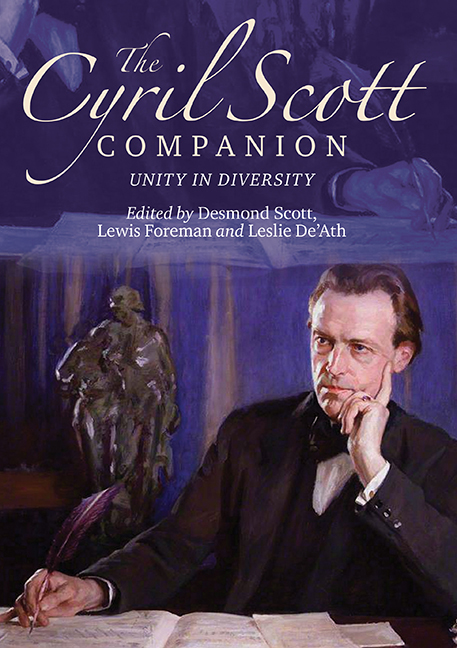Book contents
- Frontmatter
- Dedication
- Contents
- List of Illustrations
- List of Tables
- List of Contributors
- Foreword
- Preface
- Acknowledgements
- Editors' Note
- I SCOTT IN CONTEXT
- II THE MUSIC
- 8 Discovering, Editing and Recording Cyril Scott
- 9 ‘Years of Indiscretion’: The Early Piano Works, 1898–1909
- 10 ‘Like a Bird Sings’: The Piano Works from the Op. 66 Sonata to World War 1
- 11 The Later Piano Works
- 12 The Twenty-First-Century Orchestral Recordings: The Shock of the Unknown
- 13 The Chamber Music
- 14 Operas and Music for the Theatre
- 15 The Choral Works
- 16 The Songs
- III THE WRITINGS
- IV PERSONAL REMINISCENCES
- APPENDICES
- CATALOGUES, DISCOGRAPHY AND BIBLIOGRAPHY
- Index of Works
- General Index
15 - The Choral Works
from II - THE MUSIC
Published online by Cambridge University Press: 14 September 2019
- Frontmatter
- Dedication
- Contents
- List of Illustrations
- List of Tables
- List of Contributors
- Foreword
- Preface
- Acknowledgements
- Editors' Note
- I SCOTT IN CONTEXT
- II THE MUSIC
- 8 Discovering, Editing and Recording Cyril Scott
- 9 ‘Years of Indiscretion’: The Early Piano Works, 1898–1909
- 10 ‘Like a Bird Sings’: The Piano Works from the Op. 66 Sonata to World War 1
- 11 The Later Piano Works
- 12 The Twenty-First-Century Orchestral Recordings: The Shock of the Unknown
- 13 The Chamber Music
- 14 Operas and Music for the Theatre
- 15 The Choral Works
- 16 The Songs
- III THE WRITINGS
- IV PERSONAL REMINISCENCES
- APPENDICES
- CATALOGUES, DISCOGRAPHY AND BIBLIOGRAPHY
- Index of Works
- General Index
Summary
ALTHOUGH Scott is not known for his choral works, twenty of them survive, half for chorus with orchestra, and half unaccompanied or with keyboard. His interest in the medium spanned most of his creative life, from the very early setting of the Magnificat to the post-war Hymn of Unity, his ultimate musical mission statement for mankind.
MAGNIFICAT
Scott came to consider his early 1899 Magnificat ‘pretentious’, and duly consigned it and other works ‘to the crematorium, which is the best and safest place for them.’ Evidently he had yet to appreciate fully the curatorial instincts of Grainger, who arranged a piano reduction of the work and kept it safe in the museum for posterity, where it remains today. Scott's aim in his early large-scale works was ‘to invent a species of Pre-Raphaelite music, to consist mostly of common chords placed in such a way as to savour of very primitive church music, thereby, as I thought, reminding its listeners of old pictures’.
LA BELLE DAME SANS MERCI
Like the members of the Pre-Raphaelite Brotherhood, Scott found inspiration in medieval legend, especially in his early years. His own home in London, with its Burne-Jones stained-glass window, its custom furniture and austere interior appointments, was tailored to that aesthetic. Several of his vocal and choral works are settings of medieval literature, or of more modern authors with similar artistic orientation. Among the choral works, there are his La belle dame sans merci, Mirabelle, The Emir's Serenade, The Huntsman's Dirge and The Rat-Catcher. His unpublished stage adaptation of Charles de Coster's Smetse Smee similarly belongs loosely in this group, though it is a comedy in the tradition of the Belgian author's most well-known work, Till Eulenspiegel.
Keats's succinct poem of tragic love, La belle dame sans merci, elicited from Scott one of his most sensual scores. Written during World War 1, it was not published until 1935. It was first conceived (c. 1913) as a dialogue between the hapless knight and the beautiful fairy maiden, and revisited two years later with a chorus providing commentary, as the poem invites.
- Type
- Chapter
- Information
- The Cyril Scott CompanionUnity in Diversity, pp. 239 - 276Publisher: Boydell & BrewerPrint publication year: 2018



